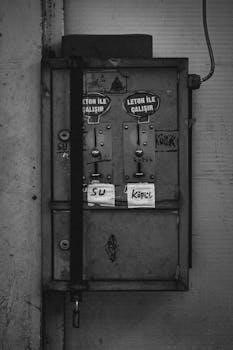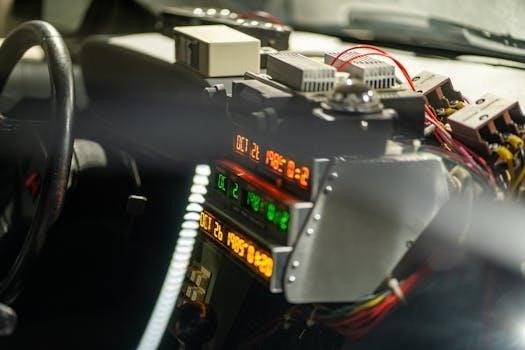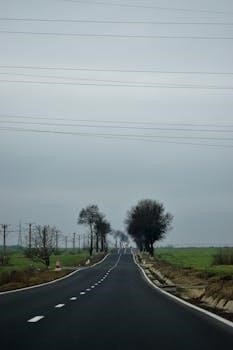4-Way Switch Wiring⁚ An Overview
4-way switch wiring allows control of a light fixture from three or more locations․
It involves a combination of 3-way and 4-way switches, utilizing traveler wires to complete the circuit․
Understanding the wiring diagrams is essential for proper and safe installation․
Understanding 4-Way Switches
4-way switches are unique components in electrical circuits․
They work in conjunction with 3-way switches to offer control from multiple points․
Their internal mechanism allows the traveler wires to be interconnected․
This creates different pathways to complete or break the circuit․
Function of a 4-Way Switch in a Circuit
The primary function of a 4-way switch within an electrical circuit is to act as an intermediary between two 3-way switches․
This configuration enables a lighting fixture to be controlled from three or more distinct locations․
Unlike 3-way switches, which have a common terminal and two traveler terminals, a 4-way switch has four traveler terminals․
These terminals are connected to two pairs of traveler wires that run between the 3-way switches․
The internal mechanism of the 4-way switch allows it to either cross-connect or straight-connect these traveler wires․
Depending on the switch’s position, it alters the path of the electrical current, thus affecting the state of the light․
Essentially, the 4-way switch serves as a versatile bridge․
It allows the circuit to be completed or interrupted from any of the control locations․
This makes it a crucial component in complex lighting systems․
It enhances convenience and flexibility in residential and commercial settings․
Difference Between 3-Way and 4-Way Switches
The key difference between 3-way and 4-way switches lies in their function and terminal configuration within a circuit․
A 3-way switch has three terminals⁚ one common and two travelers, enabling control from two locations․
In contrast, a 4-way switch features four traveler terminals, serving as an intermediary switch․
It is positioned between two 3-way switches to facilitate control from three or more locations․
3-way switches toggle between two circuits, directing power through one of the traveler wires․
4-way switches, however, don’t directly control the power source; instead, they alter the path of the traveler wires․
They either cross-connect or straight-connect them, maintaining or changing the circuit’s state․
In terms of application, 3-way switches are used for basic multi-location control, such as stairways․
4-way switches extend this control to additional locations, like large rooms with multiple entrances․
Understanding these differences is crucial for proper wiring and troubleshooting of multi-location lighting systems․
It ensures the correct switch type is used in the appropriate position within the circuit․

Wiring Configurations
Wiring configurations for 4-way switches vary based on where the power feed enters the circuit․
Common setups include power to the 3-way switch first, the 4-way switch first, or at the light fixture itself․
Each configuration requires specific wiring adjustments․
Power Feed to the 3-Way Switch First
In this configuration, the power source enters one of the 3-way switches before reaching the 4-way switch or the light fixture․ This setup is common in many homes and is relatively straightforward to wire․ The hot wire from the power source connects to the common terminal of the first 3-way switch․ Two traveler wires then run from the first 3-way switch to the 4-way switch․
The 4-way switch has four terminals, and the traveler wires are connected to these terminals in a specific manner to allow the circuit to be completed or interrupted from multiple locations․ From the 4-way switch, another set of traveler wires runs to the second 3-way switch․
The common terminal of the second 3-way switch is then connected to the light fixture․ The neutral wire from the power source goes directly to the light fixture to complete the circuit․ This configuration ensures that the light can be controlled from all three switch locations․
Power Feed to the 4-Way Switch First
Alternatively, the power source can be fed directly into the 4-way switch before connecting to the 3-way switches․ In this setup, the hot wire from the power source connects to one of the traveler terminals on the 4-way switch․ It is crucial to identify the correct terminals on the 4-way switch for this configuration to work properly․
Two traveler wires then run from the 4-way switch to the first 3-way switch․ The traveler wires are connected to the traveler terminals on the 3-way switch․ From the first 3-way switch, another traveler wire connects to the second 3-way switch․
The common terminal of one of the 3-way switches is connected to the light fixture, and the neutral wire from the power source goes directly to the light fixture․ This configuration allows the light to be controlled from all three locations, but it requires careful attention to the wiring sequence to ensure safety and functionality․ Always double-check the wiring diagram before energizing the circuit․
Power and Light at the Same Switch
In some wiring configurations, the power source and the light fixture are both located at the same switch box․ This setup requires careful wiring to ensure that the switches function correctly and that the circuit is safe․ The hot wire from the power source is connected to the common terminal of the first 3-way switch․ One of the traveler wires from the first 3-way switch is then connected to one of the traveler terminals on the 4-way switch․
The other traveler wire from the first 3-way switch is connected to the other traveler terminal on the 4-way switch․ From the 4-way switch, two traveler wires are run to the second 3-way switch․
The common terminal of the second 3-way switch is connected to the light fixture․ The neutral wire from the power source is connected directly to the light fixture․ This configuration requires careful attention to the wiring sequence to ensure that the light can be controlled from all three switch locations․ Always consult a wiring diagram and follow electrical codes when working with this type of setup․

Wiring Diagrams⁚ PDF Resources
PDF resources offer detailed schematics and wiring diagrams for various 4-way switch configurations․
These diagrams provide a visual guide to ensure accurate and safe wiring․
Downloadable PDFs are readily available for practical use․
Schematic Diagrams for 4-Way Switch Wiring
Schematic diagrams are crucial for understanding the intricacies of 4-way switch wiring․
These diagrams visually represent the connections between the switches, power source, and light fixture․
They illustrate how traveler wires are routed between the 3-way and 4-way switches to control the circuit from multiple locations․
PDF resources often include schematic diagrams that simplify the wiring process, showing the precise arrangement of wires and terminals․
A typical schematic diagram will clearly indicate the common terminals, traveler terminals, and ground connections․
Understanding these diagrams helps in troubleshooting and ensures that the wiring is done correctly․
Schematic diagrams are invaluable tools for both novice and experienced electricians․
They provide a clear, concise representation of the wiring layout․
By studying these diagrams, one can confidently tackle 4-way switch wiring projects․
These resources are essential for safe and effective electrical installations․
Wiring Diagrams for Multiple Lights
Wiring diagrams for multiple lights extend the basic 4-way switch configuration to control several light fixtures simultaneously․
These diagrams illustrate how to connect multiple lights to a 4-way switch circuit․
Understanding these diagrams is crucial for ensuring that all lights function correctly․
Typically, the lights are wired in parallel, meaning each light receives the same voltage․
PDF resources often provide detailed wiring diagrams for various multiple-light configurations․
The diagrams show how to connect the lights to the switch circuit․
These diagrams highlight the importance of proper wire sizing and grounding to handle the increased load․
Wiring multiple lights requires careful planning and attention to detail․
The diagrams help in understanding the flow of electricity and the proper connections․
These resources are essential for ensuring a safe and functional lighting system․
The diagrams also cover different scenarios, such as power feed locations and switch placements․
By following these diagrams, one can confidently install multiple lights․

Practical Wiring Tips
When wiring 4-way switches, identify traveler wires carefully․
Ensure proper grounding of the 4-way switch for safety․
Use wire connectors that are appropriate and inspect all connections․
Identifying Traveler Wires
Identifying traveler wires is crucial for successful 4-way switch wiring․
Traveler wires connect the two 3-way switches to the 4-way switch, carrying the electrical signal between them․
Unlike neutral or ground wires, traveler wires are typically identified by their connection to the brass-colored terminals on the switches․
These wires “travel” between the switches to change the state of the circuit․
In conduit systems, traveler wires might be any color, so labeling them during disconnection is a good practice․
Visually inspect the wires connected to the 4-way switch; they should be attached to the four terminals that aren’t ground․
Use a multimeter to test continuity between the terminals on the 3-way switches and the corresponding wires at the 4-way switch location․
Carefully tag or mark each traveler wire during removal to ensure correct reconnection․
This ensures the circuit functions as intended and avoids potential short circuits or other electrical problems․
Properly identified traveler wires are essential for the seamless operation of a 4-way switching system․
Grounding the 4-Way Switch
Grounding the 4-way switch is a critical safety measure in any electrical installation․
The ground wire, typically bare copper or green, provides a path for stray electrical current to safely return to the electrical panel, preventing shocks․
Connect the ground wire to the designated ground terminal on the 4-way switch, usually identified by a green screw or a grounding symbol․
Ensure the ground wire is securely fastened to the terminal to maintain a reliable connection․
If the metal electrical box is grounded, the switch can be grounded through its metal mounting straps, ensuring continuity․
Always check local electrical codes for specific grounding requirements in your area․
When replacing an old switch, carefully note the grounding configuration and replicate it on the new switch․
If the existing wiring doesn’t include a ground wire, consult a qualified electrician to upgrade the wiring for safety․
A properly grounded 4-way switch minimizes the risk of electrical hazards and protects both the user and the electrical system․
Neglecting to ground the switch can lead to dangerous conditions and is a violation of electrical safety standards․

Safety Precautions
Prioritize safety when working with electrical wiring․
Always disconnect power at the breaker before starting․
Follow electrical codes and wear appropriate safety gear․
If unsure, consult a qualified electrician․
Proper precautions prevent accidents․
Disconnecting Power Before Wiring
Before undertaking any electrical work, especially involving 4-way switches, disconnecting the power supply is the most critical safety precaution․
This measure safeguards against electric shock, which can cause severe injury or even be fatal․
Locate the circuit breaker controlling the circuit you intend to work on․
Turn the breaker to the “off” position, effectively cutting off the electrical current to that circuit․
To ensure complete safety, test the circuit using a non-contact voltage tester;
This tool verifies that no electricity is flowing through the wires․
Place the tester near the wires; if it indicates voltage, double-check that you have turned off the correct breaker․
If the tester shows no voltage, it is safe to proceed with the wiring․
Never assume that a circuit is de-energized without proper verification․
Taking these steps minimizes the risk of electrical accidents․
Following Electrical Codes
Adhering to local and national electrical codes is paramount when wiring 4-way switches․
These codes ensure safety and prevent hazards like fires and electrical shocks․
Electrical codes specify requirements for wire gauges, connections, and grounding methods․
Using the correct wire size is crucial to handle the electrical load safely․
Properly secure all wire connections to prevent loose wires, which can cause arcing․
Grounding the 4-way switch provides a path for stray electricity, reducing shock risk․
Always consult the National Electrical Code (NEC) and local regulations for specific requirements․
Local inspectors may have additional rules based on regional factors․
Ensure all work is performed by a qualified electrician to guarantee compliance․
Improper wiring can lead to serious safety issues and void insurance coverage․
Familiarize yourself with code requirements before starting any electrical project․
This knowledge ensures safe and compliant installations, protecting your home and family․
Following codes also ensures the longevity and reliability of your electrical system․
Comments